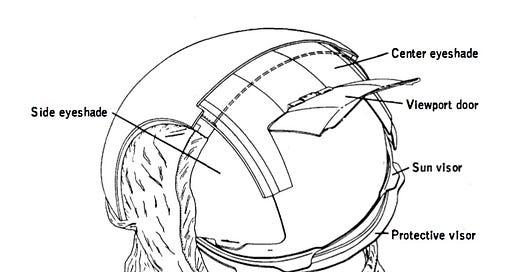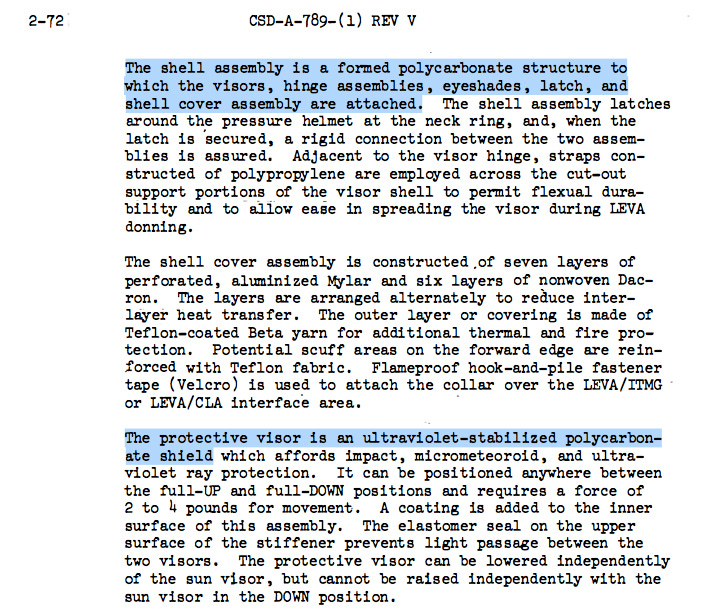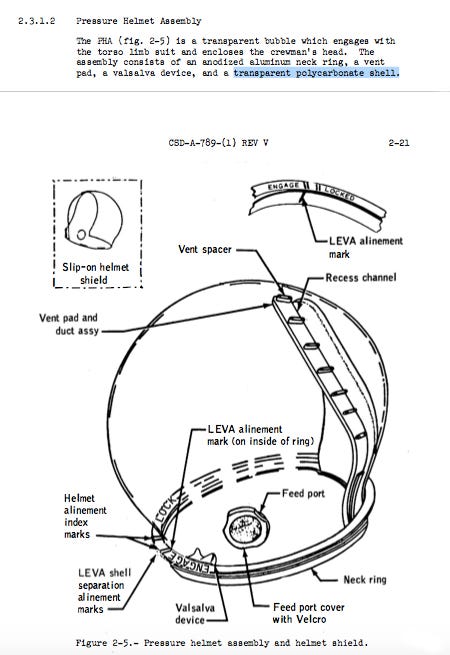All images in this article courtesy of NASA.
When I was a boy the space race in the 1960’s against the Russians and high Cold War drama. Our heroes were readily seen in Life magazine and on TV. I had the silver spacesuit for my GI Joe and I built the models of Gemini and Apollo spacecrafts. I had then, and still have, my lunch box with the Mercury capsule from back then.
And I had a toy space helmet with a green visor styled after the astronauts of Mercury and Gemini. Little did I know at the time that my plastic helmet would be made of similar materials as the real ones the astronauts wore.
I was doing some investigation into space radiation and what preparations were completed by NASA to protect the astronauts traveling to the moon and then doing EVA’s on the moon’s surface. So I downloaded the manual to the Apollo 11 spacesuit as I wanted to know what type of shielding was constructed in the suit to protect the astronauts from this life threatening hazard.
NASA has stated that any radiation in space is a hazard. Dr Bulcsu István Siklós in his paper Lunar Geology And Ionizing Radiation describes as follows:
“Astronauts on the lunar surface could in reality be exposed to every kind of radiation – alpha, beta, microwave, x-ray, gamma, Bremsstrahlung, Cherenkov radiation, Askaryan radiation, high-energy protons and neutrons, galactic cosmic rays (GCR) and solar particle events (SPE).”
This makes the surface of the moon a nuclear hazmat zone.
As I discovered in the Apollo spacesuit manual there was no mention of radiation shielding in the suit, helmet, gloves or boots. There was however, references to materials used for thermal protection in severe heat and cold that would be experienced on the moon’s surface. One would think that this would be of utmost importance but is completely ignored.
When I got the helmet I was surprised to learn it was composed entirely of polycarbonate. Or more commonly known as plastic.
Materials That Block Radiation
When one thinks of radiation blockers, lead comes to mind. Back in the day, they used a lead cover on your body when taking dental x-rays. Actually, for low level radiation such as alpha and beta rays can be blocked by one inch of paper, one centimeter of plastic or demron fabrics. More powerful radiation such as gamma rays and x-rays can only be blocked by lead shielding. Neutron radiation penetrates most materials including lead so the best solution for it is hydrogen shielding, i.e., water.
It’s of note that these shielding materials were not present in any of the vehicles NASA launched or as previously stated, in the astronaut’s spacesuit construction and design.
The Helmet
The base part of the helmet starts out as a clear bubble which is crafted from Lexan polycarbonate (i.e., plastic). The polycarbonate material is rated to handle temperatures up to 297 degrees Fahrenheit, safe enough for surface temperatures on the moon, although it will deform at above 240 degrees Fahrenheit (something never seen or documented by NASA). There is no data on this form of plastic in conjunction with below freezing temperatures.
The visor assembly along with a beta cloth hoodie fits over it. The beta cloth is fire resistant but offers no radiation protection and very little thermal shielding as well. There is no thermal shielding inside the helmet.
The only safeguard is the gold visor to reflect ultraviolet radiation, which can cause blindness.
It becomes readily apparent there is no radiation protection for the astronaut’s head. As stated previously, plastic will block alpha and beta but nothing else. This raises the question of how did these men survive radiation sickness or even death on the moon during an EVA?
Galactic Cosmic Rays (GCR)
Another dangerous type of radiation the astronauts are exposed to is Galactic Cosmic Rays (GCR). Janice L. Huff, Ph.D wrote a paper called, “Space Radiation and Risks to Human Health” in which she stated there is no shielding that can block GCR. Meaning GCR would penetrate the spacecraft shielding as well as the spacesuits.
She also stated that there was no data to evaluate human health hazards. Yet, there were 9 missions to the moon with all Apollo crews being exposed to GCR. And they do not have the human data? Why not? Or is this a subtle leak that the moon landings were sham?
In Closing
So here are astronauts in one of the most toxic environments any humans had been exposed to, worse than Chernobyl and Fukushima combined, and these brave explorers just passed through it unscathed despite having poor to nonexistent shielding to protect them. Did NASA use classified black budget technology to shield them? That is currently unknown. If not, then we are looking at a con job.
Because they all should have died.
Notes
NASA’s gamma ray experiments on the helmet showed no protection at all, with the gamma rays easily passing through the thin polycarbonate structure.
The moon itself is radioactive. NASA’s science site (see link below) states that gamma rays cause nuclear reactions in the soil making it radioactive. Astronauts have said the moon soil (regolith) got all over their suits and gear, with one astronaut stating that some got in his mouth. Yet, none of them ever got radiation sickness or resulting health issues from exposure to moon dirt.
Likewise, there is no protection for the hands or feet.
Read more about the Apollo space suits in my review Spacesuit—Fashioning Apollo by Nicholas de Monchau. A detailed account of spacesuit development that totally ignores radiation shielding in the suit (because there is none) and ignores the helmet completely.
https://outwardtrends.blogspot.com/2019/07/book-review-fashioning-apollo-by.html
Janice L. Huff, Ph.D., is the Deputy Element Scientist at the NASA Space Radiation Program and her report can be found on NASA’s technical report server. Link below.
Sources
NASA Spacesuit manual
https://www.hq.nasa.gov/alsj/alsj-EMU1.pdf
LUNAR GEOLOGY AND IONISING RADIATION from a Revisionist Perspective by Dr. Bulcsu István Siklós
https://www.aulis.com/lunar_surface_radiation.htm
https://www.aulis.com/PDF/lunar_geology.pdf
Space Radiation and Risks to Human Health by Janice L. Huff, Ph.D
https://ntrs.nasa.gov/api/citations/20140005866/downloads/20140005866.pdf
What Materials Block Radiation?
https://med-pro.net/what-materials-block-radiation/
Moon Soil Radioactive
https://science.nasa.gov/science-news/science-at-nasa/2005/08sep_radioactivemoon
NASA Technical Reports Site






